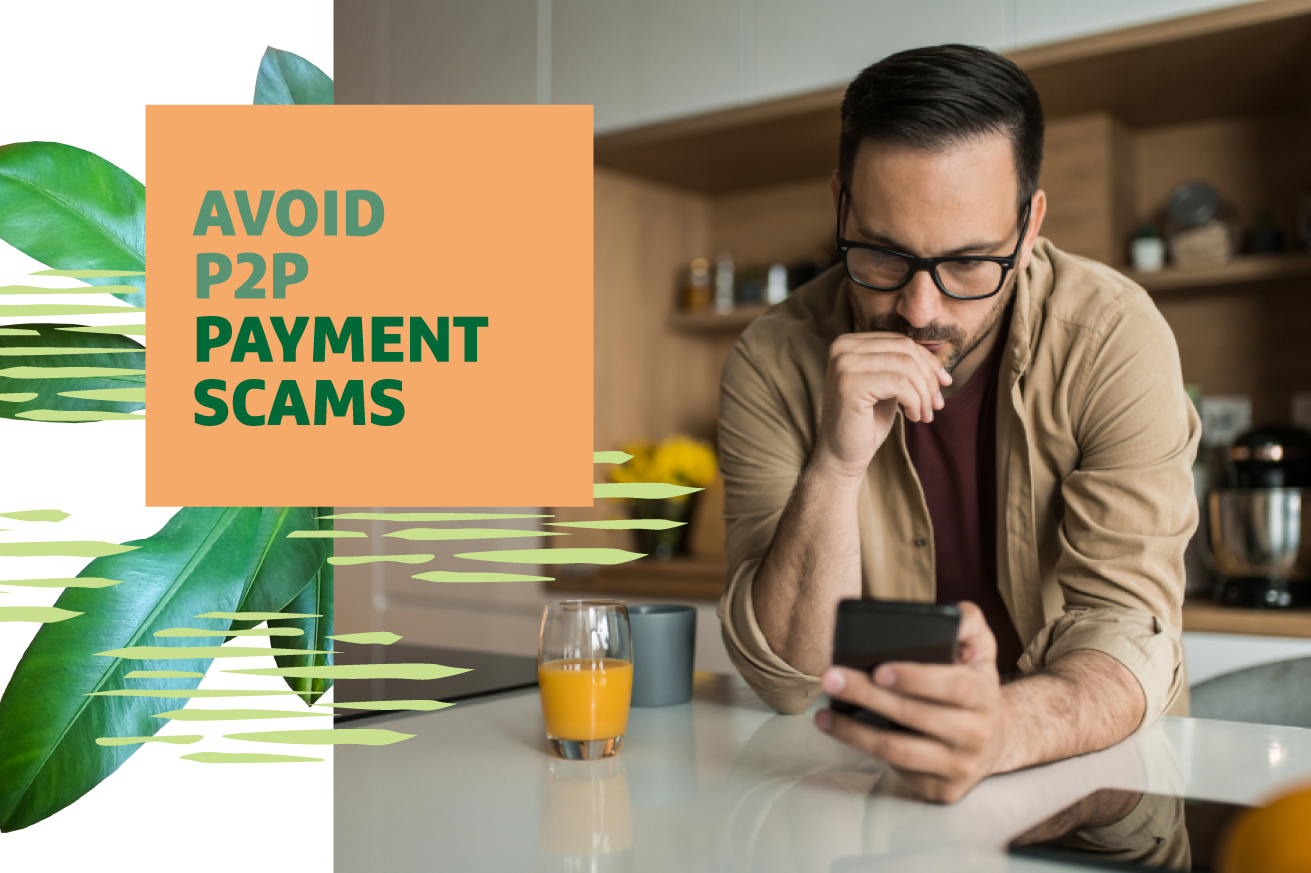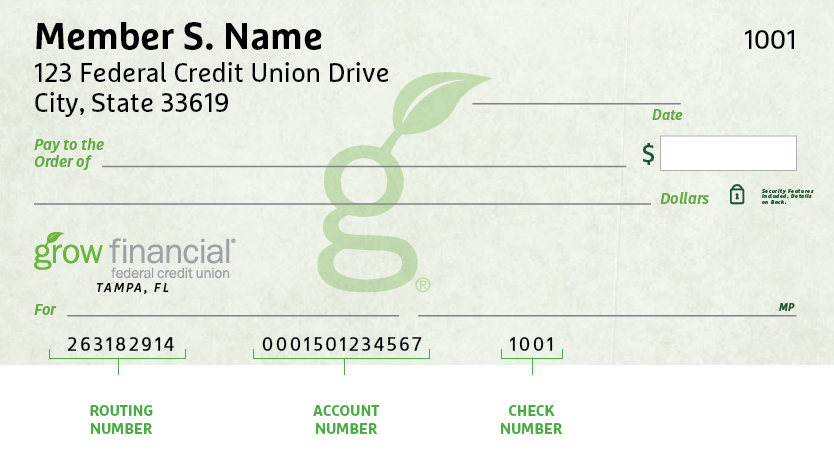- Personal
- Membership
- Membership
- Rates & Fees
- Checking
- Checking
- Personal Loans
- Personal Loans
- Wealth Management
- Investment Services
- Financial Advisors
- Resource Center
- Business

November 19, 2024
Fraud Alert: Watch Out for Peer-to-Peer Payment Scams
Popular peer-to-peer (P2P) payment apps, such as Venmo, Cash App, PayPal and Zelle®, are convenient targets for scammers. Most transactions through these payment services aren’t protected by the comprehensive liability guarantees that consumers expect from their credit cards and financial institutions. Usually, once your money is gone from these apps, it’s gone for good.
Common payment scams to avoid
In most P2P payment scams, fraudsters add money to their accounts using fraudulent sources, such as stolen credit or debit cards, then use that money to conduct transactions. The funds eventually get flagged as fraudulent by the P2P provider, but by then, the scammer is long gone with cash or merchandise. Here are some of the most common P2P scams to watch out for:
- Mystery money
In this scam, a stranger “accidentally” sends you money through a P2P app, then asks you to send the money back. Once you do, they cash out and disappear. When the P2P provider flags the transaction as fraudulent, you’re left on the hook to return the funds. Plus, the provider might think you’re complicit in the fraud and block your account. - Dishonest buyer
Let’s say you’ve listed an item for private sale through Facebook or craigslist. The scammer pays you using Venmo, Cash App, Zelle or a similar app and picks up the item or asks you to ship it somewhere. Soon after, the P2P provider identifies the funds as fraudulent, leaving you responsible for the amount — and without the item you sold. - Work-from-home scam
You get hired for a remote job you applied for through a popular job search website, and your new employer sends you a check for some reason, such as setting up your direct deposit or paying for new computer equipment. They then ask you to forward some of the money to someone else using a P2P app for another legitimate-sounding reason. But here’s the catch: the check was fake all along. Once it bounces, you’ll be liable for the full amount, leaving you out of both money and the supposed job. - Fake business transaction
Some scammers pretend to be a legitimate businesses and request a P2P payment for a product or service. But after a scammer has your money, the product never arrives and the scammer disappears. - Imposter fraud
Scammers pose as a representatives from fraud departments or well-known merchants and ask you to verify sensitive information, such as your bank login, credit card details or Social Security number. Sharing this information with them allows the scammer to set up a P2P account in your name, steal your identity and gain access to your financial accounts.
Even worse, in addition to stealing your money, items or personal information, some of these payment scams use you as a money mule, a growing type of illegal activity. Learn more about money mule scams.
How to stay safer when using P2P apps
P2P payment apps are convenient for sending money to friends, but they can be risky when transacting with strangers. Keep these tips in mind for using payment apps more safely:
- Send or receive money from people only if you know them personally.
- Always verify that you’re transacting with the correct person by double-checking their phone number since scammers can easily impersonate others by changing their name and photo.
- Be cautious about accepting funds from strangers.
- Avoid sending money for a purchase until you’ve received what you paid for, or only use a P2P service that offers a purchase protection option.
- Contact the P2P service’s customer support directly if you’ve received an unexpected payment. Don’t send money back to strangers, as this could be part of a scam.
When in doubt, use credit cards with zero liability purchase protection, such as Grow Visa® credit cards, which are safer payment methods for online transactions.
Want to learn more about avoiding scams? Visit our Education page and sort by Security Education to find more security-related topics.
Posted In:
Lost or Stolen Card?
We’re here to help. If your card has been misplaced or stolen, we’ll act quickly to protect your account. You can report a missing card in the following ways:
Online and Mobile Banking
Log in and follow these three easy steps:
- From the menu, select Tools
- Select Card Manager
- Report your card as Lost or Stolen*
By phone or at a Grow store
Call 800.839.6328 to speak to a team member or let us know in person at any Grow store.Notice: Taking these steps will immediately cancel your card to prevent unauthorized transactions. If you find your card later after reporting it lost or stolen, it cannot be reactivated.
*The selected card will be canceled and removed from Manage Cards when it is reported as lost. Once your new card has been issued, it will be available in Manage Cards. The replacement card will have a new card number. Your replacement card will be sent to the mailing address on your account, and you should receive it within 7 to 10 business days.
How to Find Your Routing & Account Numbers
When you make a payment online, by phone or on a mobile device, you may be asked for our routing number and your checking account number. Credit unions and banks use these numbers to identify accounts and make sure money gets where it’s supposed to be. You’ll also need to provide your routing and checking account numbers for:
- Direct deposits
- Electronic checks
- Military allotments
- Wire transfers
Where to Find Your Routing & Checking Account Numbers
Your personal checks include both our routing number and your account number, as shown on the Grow check example below.

Where to Find Your Checking Account Number in Grow Online and Mobile Banking
If you don’t have a physical check on hand, you can also locate your Checking Account Number for Electronic Transactions in Grow Online and Mobile Banking.*
Here’s how to find it:
- In the Grow Mobile Banking app, select your checking account, then tap Show Details in the top right corner.
- In Grow Online Banking, select your checking account, then click Account Details.
Don’t have a Grow check or Online Banking? No worries.
Visit any Grow store or call us and ask for a Direct Deposit Form. It lists both your routing number and checking account number.
Making a Loan Payment
When it comes to making payments, we try to make it as painless as possible to pay your loan every month. We have several different ways to pay, including convenient online options.
Pay Online
You have two ways to pay online by transferring funds from another bank or credit union.
- Grow Online Banking (Preferred payment method for any loan)
This is the simplest way to pay your loan. You can make one-time payments or set up automatic recurring payments in Grow Online Banking. Once you log in, select “Transfer/Payments” from the menu. If you’re not enrolled in Grow Online Banking yet, you can set up your account in just a few minutes.
Log In
- Debit Card or ACH (Available for auto, personal loans and HELOCs)
Note: ACH and debit card payments are not available for credit cards or most mortgages, except HELOCs.
We accept ACH payments with no additional fees, consumer Mastercard® and Visa® debit cards with a convenience fee of $4.95, or commercial Mastercard® and Visa® debit cards with a convenience fee of 2.95% of the payment amount. To get started with an online ACH or debit card payment, select Pay Now below.
Pay Now
Pay by Mail
You can also pay any Grow loan by check through the mail. Please remember to include your account number and Grow loan number on the check. (For credit card payments, please do not write your 16-digit credit card number on the check, which can cause a delay in processing the payment.)
Address for auto, credit card, personal loan and HELOC payments:
Grow Financial Federal Credit Union
P.O. Box 75466
Chicago, IL 60675-5466Address for personal first or second mortgages and home equity payments:
Grow Financial Federal Credit Union
P.O. Box 11733
Newark, NJ 07101-4733You Are About To Leave GrowFinancial.org
At certain places on this site, there are links to other websites. Grow Financial Federal Credit Union does not endorse, approve, represent, certify or control those external sites. The credit union does not guarantee the accuracy, completeness, efficacy, timeliness or accurate sequencing of the information contained on them. You will not be represented by Grow Financial Federal Credit Union if you enter into a transaction. Privacy and security policies may differ from those practiced by the credit union. Click CONTINUE if you wish to proceed.
